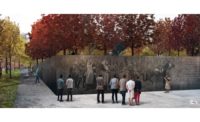A federal commission is accepting entries for a competition to design a Washington, D.C. monument honoring Dwight D. Eisenhower, the United States' 34th president.
For a four-acre site just south of the Mall divided by Maryland Avenue S.W., and near many Cabinet agencies that Eisenhower had a hand in creating, the Dwight D. Eisenhower Memorial Commission seeks proposals that emphasize open spaces with little in the way of actual buildings or statuary. Indeed, one of the only requirements is a canopy to protect against rain, plus 2,500 square feet of enclosed space for a bookshop, bathrooms, and ranger station, though that could be contained in one structure or several, says Daniel Feil, FAIA and commission spokesman. The $110 million project is part of the General Services Administration’s Design Excellence program.
Despite not offering a traditional museum, the memorial should feature an interactive electronic element, so schoolchildren can download biographical information about Eisenhower, who was also the Allied forces’ commanding general in Europe during World War II, Feil adds.
Owing to both the minimalist approach and urban location, this presidential memorial could look quite different than, say, the Washington Monument, a soaring obelisk surrounded by lawns. “It’s the first civic square for a president that’s ever been done in D.C.,” says Feil. The commission plans to complete the project by 2013.
The GSA announced the competition on August 15. The first deadline for the design phase, which is open to non-architects, is October 8; submissions should include examples of past projects, especially in city settings. A 12-member panel will evaluate the entries.
Split between two sections, the memorial’s site is divided diagonally by the 11-lane-wide Maryland Avenue. The northern half-acre triangle, owned by the National Park Service, features community gardens; the 1.5-acre southern triangle, meanwhile, contains a plaza for the Department of Education, which Eisenhower helped form.
Under the competition’s guidelines, designers can connect the halves by closing the two-acre section of Maryland Avenue. That suggestion, however, doesn’t sit well with the National Coalition to Save Our Mall, an eight-year-old group that advocates rehabbing the street. “Maryland could become a grand counterpart to Pennsylvania Avenue, lined with all kinds of activity,” says coalition president Judy Scott Feldman, citing planner Pierre L’Enfant’s original hub-and-spoke layout. “But the city wants to give it away.”
For more information, visit the GSA’s competition announcement.





Post a comment to this article
Report Abusive Comment